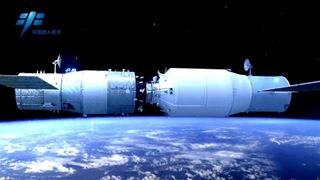
Chinese Cargo Spacecraft Burns Up in Earth's Atmosphere

China's first resupply craft, Tianzhou-1, has been deorbited under orders from ground controllers.
Following a set of braking maneuvers, the robotic cargo ship plunged into Earth's atmosphere and burned up late Friday (Sept. 22) Beijing time, according to China's state-run Xinhua news agency.
Tianzhou-1 launched on April 20 and docked with China's orbiting Tiangong-2 space lab two days later.
Over the past five months, Tianzhou-1 and Tiangong-2 accomplished a trio of refueling sequences: One on April 27, a second on June 15 and a final one on Sept. 16, Xinhua reported.
Tiangong-2 was unoccupied during these activities.
Chinese space officials view the refueling and docking activities as a prelude to the country's building of a larger space station in the mid- 2020s.
Leonard David is author of "Mars: Our Future on the Red Planet," published by National Geographic. The book is a companion to the National Geographic Channel series "Mars." A longtime writer for Space.com, David has been reporting on the space industry for more than five decades. Follow us @Spacedotcom, Facebook or Google+. This version of this story was posted on Space.com.
Get the Space.com Newsletter
Breaking space news, the latest updates on rocket launches, skywatching events and more!
Join our Space Forums to keep talking space on the latest missions, night sky and more! And if you have a news tip, correction or comment, let us know at: community@space.com.

Leonard David is an award-winning space journalist who has been reporting on space activities for more than 50 years. Currently writing as Space.com's Space Insider Columnist among his other projects, Leonard has authored numerous books on space exploration, Mars missions and more, with his latest being "Moon Rush: The New Space Race" published in 2019 by National Geographic. He also wrote "Mars: Our Future on the Red Planet" released in 2016 by National Geographic. Leonard has served as a correspondent for SpaceNews, Scientific American and Aerospace America for the AIAA. He was received many awards, including the first Ordway Award for Sustained Excellence in Spaceflight History in 2015 at the AAS Wernher von Braun Memorial Symposium. You can find out Leonard's latest project at his website and on Twitter.
